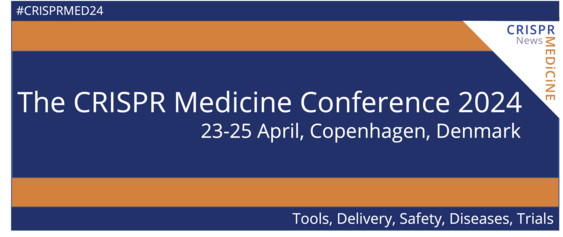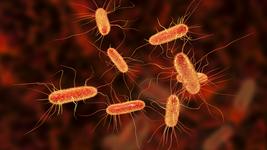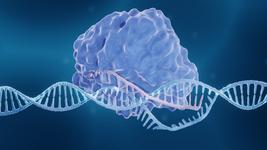First World CRISPR Day Celebrates Progress and Highlights Opportunities and Challenges Ahead

The inaugural World CRISPR Day, a virtual event bringing together much of the international CRISPR research community, featured lectures and discussion of many key issues involved with using the technology to develop therapeutics, diagnostics, and other practical applications.
»The rapid impact CRISPR has created in the life sciences and beyond in less than a decade is incredible,« said Paul Dabrowski, CEO of genome engineering company Synthego, which hosted the event. »From the early days as a tool of widely anticipated but speculative reach to becoming a routine technique in thousands of laboratories and companies, now generating breakthrough insights in a multitude of areas and transforming how new medicines are created.«
The event featured recent Nobel Prize winner (along with Emmanuelle Charpentier, of the Max Planck Institute of Infection Biology in Berlin) Jennifer Doudna, of the University of California, Berkeley. Dr. Doudna gave a keynote address about the science behind CRISPR, and its potential to prevent and cure disease. »It's a technology that allows anyone with a little bit of schooling in molecular biology to manipulate the genome,« she said. »And that comes with extraordinary opportunity as well as incredible responsibility.«
Dr. Doudna stressed that the technology, now being used across thousands of laboratories and companies for an enormous range of applications, arose out of purely curiosity-driven research. She and her colleagues had grown interested in the bacterial immune system and the way bacteria apparently protected themselves against invading viruses. It was only after this system was better understood that CRISPR-Cas9 became the widely utilised tool it is today.
One of the most important advances Drs. Doudna and Charpentier made, along with their students at the time, »was to combine what in nature are two separate RNA molecules that guide Cas9 into a single guide format,« she said. »And that really turns this into a robust two-component tool—one protein and one guide RNA that can be used to define a sequence for cutting in a genome.« That simplified tool can now be used not just to engineer changes to a genome but also to control transcription, allow imaging of sites within the genome, and in general allow marking and manipulating specific sequences.
It was that combination of RNA molecules that showed Dr. Doudna the potential of the project. »This was, for us, that proverbial moment, when we realised that a curiosity-driven project—to understand bacterial immunity—had morphed into something really interesting and different from what we imagined when we started the project.«
Dr. Doudna said that among the many opportunities to make use of the CRISPR-Cas9 platform, curing genetic diseases is among the most exciting. »Just a few short years ago this would have sounded like science fiction, but today we are at a point where we can manipulate DNA in cells in the laboratory to correct disease-causing mutations.«
She noted that the most promising early results have been seen in sickle cell disease, a genetic disorder caused by a single mutation in the gene that encodes the β-subunit of haemoglobin. Clinical trials are underway using CRISPR to treat the disease, and, as was reported earlier this year, one patient has already been shown to be effectively cured.
»[This] is very exciting for the field, but also brings with it, I think, extraordinary challenges in terms of access and making sure that this tech is available to all of those around the world that need it,« Dr. Doudna said.
One of the key challenges moving forward, she said, is delivery: bringing the molecules into the cells or tissues where they are needed. »For all of you that are starting out your scientific career: this is an area where we need real innovation,« Dr. Doudna said. »We need smart people thinking creatively about how to do this, and how to do this effectively into specific types of cells. This will be one way that we can reduce the cost and make these technologies more widely available worldwide.«
She also spoke about the continued need to address the safety of the technology when used in humans, and for continued discussion and guidelines regarding the ethical issues that arise given the power of the technology. There are also other exciting areas of research, including CRISPR’s use in diagnostics, even potentially for use during the COVID-19 pandemic and any other similar challenges that arise in the future.
»The platform, this RNA-guided mechanism of recognition, is a very versatile way to manipulate DNA and cells,« Dr. Doudna concluded. »I don’t doubt that we’ll see continued advance of the technology—exciting, new clever ways to use that fundamental way to manipulate genomes.«
“Today we stand on the shoulders of giants. I believe that hundreds if not thousands of medicines will be developed using CRISPR in the coming years - Paul Dabrowski, CEO Synthego”
Cell and Gene Therapy, and More
Another session at the World CRISPR Day event focused on the technology’s use in cell and gene-editing therapies. Waseem Qasim, of University College London, discussed the potential to edit T cells and update the now relatively routinely used CAR T-cell therapy. CAR T-cell therapy does have some limitations, including side effects and the problem of requiring bespoke products tailored for each individual patient. »We can address some of these by introducing gene editing technology,« he said.
The first efforts involving editing of T cells used TALENs (transcription-activator-like effector nucleases), but Dr. Qasim said the goal is now to move from TALENs to CRISPR. His group has recently opened a phase I trial involving CRISPR-CAR19-edited allogenic T cells in paediatric relapsed or refractory B-cell acute lymphoblastic leukaemia. »The ambition is to get them into remission, and have clearance of disease without side effects.«
Also in this session, Donald B. Kohn, of the University of California, Los Angeles, spoke about using gene editing with haematopoietic stem cells. This field has also progressed rapidly over the last several years, and another small phase I trial will soon open involving nine patients with severe sickle cell disease. The first patient will be enrolled in 2021, and will receive CRISPR-Cas9-corrected haematopoietic stem cells.
Other sessions included expert discussion of how CRISPR is allowing deeper study and understanding of genome biology, potential other applications of the technology from merging of CRISPR with electrical transistors to novel diagnostics, and some of the educational and engineering challenges the future will hold.
»Today we stand on the shoulders of giants,« said Dabrowski, the Synthego CEO. »I believe that hundreds if not thousands of medicines will be developed using CRISPR in the coming years.«
Dave Levitan is a science journalist based in the U.K.
Tags
ArticleNewsAcute Lymphoblastic Leukemia, ALLCOVID-19Sickle Cell Disease, SCDCRISPR-CasCas9
CLINICAL TRIALS
Sponsors:
National Institute of Allergy and Infectious Diseases (NIAID)








